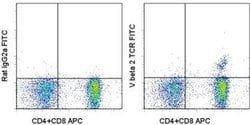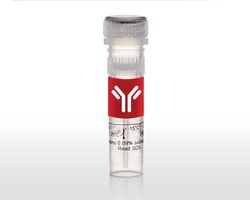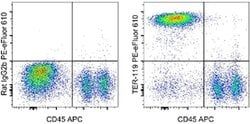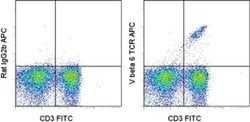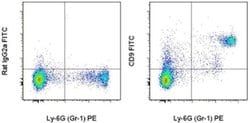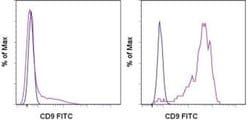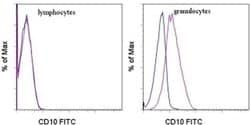50-942-3
CD9 Monoclonal Antibody (eBioKMC8 (KMC8)), FITC, eBioscience™, Invitrogen™
Manufacturer: Invitrogen
Select a Size
| Pack Size | SKU | Availability | Price |
|---|---|---|---|
| Each of 1 | 50-942-3-Each-of-1 | In Stock | ₹ 14,774.00 |
50-942-3 - Each of 1
In Stock
Quantity
1
Base Price: ₹ 14,774.00
GST (18%): ₹ 2,659.32
Total Price: ₹ 17,433.32
Antigen
CD9
Classification
Monoclonal
Concentration
0.5 mg/mL
Formulation
PBS with 0.1% gelatin and 0.09% sodium azide; pH 7.2
Gene Accession No.
P40240
Gene Symbols
Cd9
Purification Method
Affinity chromatography
Regulatory Status
RUO
Gene ID (Entrez)
12527
Content And Storage
4° C, store in dark, DO NOT FREEZE!
Form
Liquid
Applications
Flow Cytometry
Clone
eBioKMC8 (KMC8)
Conjugate
FITC
Gene
Cd9
Gene Alias
5H9, BA2, BTCC-1, DRAP-27, GIG2, MIC3, MRP-1, P24, TSPAN-29
Host Species
Rat
Quantity
100 μg
Primary or Secondary
Primary
Target Species
Mouse
Product Type
Antibody
Isotype
IgG2a κ
Description
- Description: The eBioKMC8 monoclonal antibody reacts with mouse CD9, a 24 kDa member of the transmembrane 4 superfamily
- This family is characterized by the presence of four hydrophobic domains spanning the cell membrane and short N- and C-terminal cytoplasmic domains
- CD9 is expressed by several cell types including monocytes, macrophages, platelets, early B cells, activated B and T cells, dendritic cells, eosinophils, basophils, endothelial cells, myoblasts and neuroblasts
- On T cells, CD9 functions as a co-stimulatory molecule on naive T cells
- Furthermore, CD9 is expressed in oocytes, and CD9-deficiency results in sterility caused by defective gamete fusion
- In mouse macrophages, CD9 functionally associates with FcgammaRs to modify signals for phagocytosis and inflammatory responses
- In mouse B cells, it was discovered that CD9 is a marker for marginal zone B cells, B1 cells, and plasma cells
- In dendritic cells, recently it was demonstrated that CD9 facilitates the association of heterologous MHC II molecules
- The level of CD9 expression is subject to donor variability
- Applications Reported: This eBioKMC8 (KMC8) antibody has been reported for use in flow cytometric analysis
- Applications Tested: This eBioKMC8 (KMC8) antibody has been tested by flow cytometric analysis of mouse splenocytes and bone marrow cells
- This can be used at less than or equal to 1 µg per test
- A test is defined as the amount (µg) of antibody that will stain a cell sample in a final volume of 100 µL
- Cell number should be determined empirically but can range from 10^5 to 10^8 cells/test
- It is recommended that the antibody be carefully titrated for optimal performance in the assay of interest
- Excitation: 488 nm; Emission: 520 nm; Laser: Blue Laser
- Filtration: 0.2 μm post-manufacturing filtered
- CD9 antigen is a glycoprotein expressed on the surface of developing B lymphocytes, platelets, monocytes, eosinophils, basophil, stimulated T lymphocytes and by neurons and glial cells in the peripheral nervous system
- CD9 belongs to a family of membrane proteins termed tetraspanins which transverse the membrane four times
- In pre B cells and platelets, CD9 antigen regulates cell activation and aggregation possibly through an association with the integrin CD41 / CD61 (GPIIb / GPIIIa)
- CD9 is involved in cell motility, osteoclastogenesis, neurite outgrowth, myotube formation, and sperm-egg fusion, plays roles in cell attachment and proliferation and is necessary for association of heterologous MHC II molecules on the dendritic cell plasma membrane which is important for effective T cell stimulation
- CD9 functions in many cellular processes including differentiation, adhesion, and signal transduction, and expression plays a critical role in the suppression of cancer cell motility and metastasis
- CD9 is also considered as metastasis suppressor in solid tumors.
Compare Similar Items
Show Difference
Antigen: CD9
Classification: Monoclonal
Concentration: 0.5 mg/mL
Formulation: PBS with 0.1% gelatin and 0.09% sodium azide; pH 7.2
Gene Accession No.: P40240
Gene Symbols: Cd9
Purification Method: Affinity chromatography
Regulatory Status: RUO
Gene ID (Entrez): 12527
Content And Storage: 4° C, store in dark, DO NOT FREEZE!
Form: Liquid
Applications: Flow Cytometry
Clone: eBioKMC8 (KMC8)
Conjugate: FITC
Gene: Cd9
Gene Alias: 5H9, BA2, BTCC-1, DRAP-27, GIG2, MIC3, MRP-1, P24, TSPAN-29
Host Species: Rat
Quantity: 100 μg
Primary or Secondary: Primary
Target Species: Mouse
Product Type: Antibody
Isotype: IgG2a κ
Antigen:
CD9
Classification:
Monoclonal
Concentration:
0.5 mg/mL
Formulation:
PBS with 0.1% gelatin and 0.09% sodium azide; pH 7.2
Gene Accession No.:
P40240
Gene Symbols:
Cd9
Purification Method:
Affinity chromatography
Regulatory Status:
RUO
Gene ID (Entrez):
12527
Content And Storage:
4° C, store in dark, DO NOT FREEZE!
Form:
Liquid
Applications:
Flow Cytometry
Clone:
eBioKMC8 (KMC8)
Conjugate:
FITC
Gene:
Cd9
Gene Alias:
5H9, BA2, BTCC-1, DRAP-27, GIG2, MIC3, MRP-1, P24, TSPAN-29
Host Species:
Rat
Quantity:
100 μg
Primary or Secondary:
Primary
Target Species:
Mouse
Product Type:
Antibody
Isotype:
IgG2a κ
Antigen: CD9
Classification: Monoclonal
Concentration: 5 μL/Test
Formulation: PBS with 0.2% BSA and 0.09% sodium azide; pH 7.2
Gene Accession No.: P21926
Gene Symbols: CD9
Purification Method: Affinity chromatography
Regulatory Status: RUO
Gene ID (Entrez): 928
Content And Storage: 4° C, store in dark, DO NOT FREEZE!
Form: Liquid
Applications: Flow Cytometry
Clone: eBioSN4 (SN4 C3-3A2)
Conjugate: FITC
Gene: CD9
Gene Alias: 5H9; 5H9 antigen; antigen CD9; BA2; BA-2/p24 antigen; BTCC-1; CD9; CD9 antigen; CD9 antigen (p24); CD9 molecule; cell growth-inhibiting gene 2 protein; DRAP-27; GIG2; Leukocyte antigen MIC3; MIC3; motility related protein-1; Motility-related protein; MRP-1; p24; sCD 9; sCD9; soluble CD 9; soluble CD9; Tetraspanin29; Tetraspanin-29; transmembrane protein CD9; TSPAN29; Tspan-29
Host Species: Mouse
Quantity: 25 Tests
Primary or Secondary: Primary
Target Species: Human
Product Type: Antibody
Isotype: IgG1 κ
Antigen:
CD9
Classification:
Monoclonal
Concentration:
5 μL/Test
Formulation:
PBS with 0.2% BSA and 0.09% sodium azide; pH 7.2
Gene Accession No.:
P21926
Gene Symbols:
CD9
Purification Method:
Affinity chromatography
Regulatory Status:
RUO
Gene ID (Entrez):
928
Content And Storage:
4° C, store in dark, DO NOT FREEZE!
Form:
Liquid
Applications:
Flow Cytometry
Clone:
eBioSN4 (SN4 C3-3A2)
Conjugate:
FITC
Gene:
CD9
Gene Alias:
5H9; 5H9 antigen; antigen CD9; BA2; BA-2/p24 antigen; BTCC-1; CD9; CD9 antigen; CD9 antigen (p24); CD9 molecule; cell growth-inhibiting gene 2 protein; DRAP-27; GIG2; Leukocyte antigen MIC3; MIC3; motility related protein-1; Motility-related protein; MRP-1; p24; sCD 9; sCD9; soluble CD 9; soluble CD9; Tetraspanin29; Tetraspanin-29; transmembrane protein CD9; TSPAN29; Tspan-29
Host Species:
Mouse
Quantity:
25 Tests
Primary or Secondary:
Primary
Target Species:
Human
Product Type:
Antibody
Isotype:
IgG1 κ
Antigen: CD9
Classification: Monoclonal
Concentration: 5 μL/Test
Formulation: PBS with 0.2% BSA and 0.09% sodium azide; pH 7.2
Gene Accession No.: P21926
Gene Symbols: CD9
Purification Method: Affinity chromatography
Regulatory Status: RUO
Gene ID (Entrez): 928
Content And Storage: 4° C, store in dark, DO NOT FREEZE!
Form: Liquid
Applications: Flow Cytometry
Clone: eBioSN4 (SN4 C3-3A2)
Conjugate: FITC
Gene: CD9
Gene Alias: 5H9; 5H9 antigen; antigen CD9; BA2; BA-2/p24 antigen; BTCC-1; CD9; CD9 antigen; CD9 antigen (p24); CD9 molecule; cell growth-inhibiting gene 2 protein; DRAP-27; GIG2; Leukocyte antigen MIC3; MIC3; motility related protein-1; Motility-related protein; MRP-1; p24; sCD 9; sCD9; soluble CD 9; soluble CD9; Tetraspanin29; Tetraspanin-29; transmembrane protein CD9; TSPAN29; Tspan-29
Host Species: Mouse
Quantity: 100 Tests
Primary or Secondary: Primary
Target Species: Human
Product Type: Antibody
Isotype: IgG1 κ
Antigen:
CD9
Classification:
Monoclonal
Concentration:
5 μL/Test
Formulation:
PBS with 0.2% BSA and 0.09% sodium azide; pH 7.2
Gene Accession No.:
P21926
Gene Symbols:
CD9
Purification Method:
Affinity chromatography
Regulatory Status:
RUO
Gene ID (Entrez):
928
Content And Storage:
4° C, store in dark, DO NOT FREEZE!
Form:
Liquid
Applications:
Flow Cytometry
Clone:
eBioSN4 (SN4 C3-3A2)
Conjugate:
FITC
Gene:
CD9
Gene Alias:
5H9; 5H9 antigen; antigen CD9; BA2; BA-2/p24 antigen; BTCC-1; CD9; CD9 antigen; CD9 antigen (p24); CD9 molecule; cell growth-inhibiting gene 2 protein; DRAP-27; GIG2; Leukocyte antigen MIC3; MIC3; motility related protein-1; Motility-related protein; MRP-1; p24; sCD 9; sCD9; soluble CD 9; soluble CD9; Tetraspanin29; Tetraspanin-29; transmembrane protein CD9; TSPAN29; Tspan-29
Host Species:
Mouse
Quantity:
100 Tests
Primary or Secondary:
Primary
Target Species:
Human
Product Type:
Antibody
Isotype:
IgG1 κ
Antigen: CD10
Classification: Monoclonal
Concentration: 5 μL/Test
Formulation: PBS with 0.2% BSA and 0.09% sodium azide; pH 7.2
Gene Accession No.: P08473
Gene Symbols: Mme
Purification Method: Affinity chromatography
Regulatory Status: RUO
Gene ID (Entrez): 4311
Content And Storage: 4° C, store in dark, DO NOT FREEZE!
Form: Liquid
Applications: Flow Cytometry
Clone: eBioCB-CALLA (CB-CALLA)
Conjugate: FITC
Gene: Mme
Gene Alias: 6030454K05Rik; Atriopeptidase; C85356; CALLA; CD10; CMT2T; common acute lymphoblastic leukemia antigen; common acute lymphocytic leukemia antigen; Enkephalinase; EPN; membrane metallo endopeptidase; membrane metalloendopeptidase; membrane metallo-endopeptidase; membrane metallo-endopeptidase (neutral endopeptidase, enkephalinase, CALLA, CD10); membrane metallo-endopeptidase (neutral endopeptidase/enkephalinase); membrane metallo-endopeptidase variant 1; membrane metallo-endopeptidase variant 2; MME; NEP; neprilysin; neprilysin-390; neprilysin-411; neutral endopeptidase 24.11; SFE; Skin fibroblast elastase
Host Species: Mouse
Quantity: 100 Tests
Primary or Secondary: Primary
Target Species: Human
Product Type: Antibody
Isotype: IgG2b κ
Antigen:
CD10
Classification:
Monoclonal
Concentration:
5 μL/Test
Formulation:
PBS with 0.2% BSA and 0.09% sodium azide; pH 7.2
Gene Accession No.:
P08473
Gene Symbols:
Mme
Purification Method:
Affinity chromatography
Regulatory Status:
RUO
Gene ID (Entrez):
4311
Content And Storage:
4° C, store in dark, DO NOT FREEZE!
Form:
Liquid
Applications:
Flow Cytometry
Clone:
eBioCB-CALLA (CB-CALLA)
Conjugate:
FITC
Gene:
Mme
Gene Alias:
6030454K05Rik; Atriopeptidase; C85356; CALLA; CD10; CMT2T; common acute lymphoblastic leukemia antigen; common acute lymphocytic leukemia antigen; Enkephalinase; EPN; membrane metallo endopeptidase; membrane metalloendopeptidase; membrane metallo-endopeptidase; membrane metallo-endopeptidase (neutral endopeptidase, enkephalinase, CALLA, CD10); membrane metallo-endopeptidase (neutral endopeptidase/enkephalinase); membrane metallo-endopeptidase variant 1; membrane metallo-endopeptidase variant 2; MME; NEP; neprilysin; neprilysin-390; neprilysin-411; neutral endopeptidase 24.11; SFE; Skin fibroblast elastase
Host Species:
Mouse
Quantity:
100 Tests
Primary or Secondary:
Primary
Target Species:
Human
Product Type:
Antibody
Isotype:
IgG2b κ
